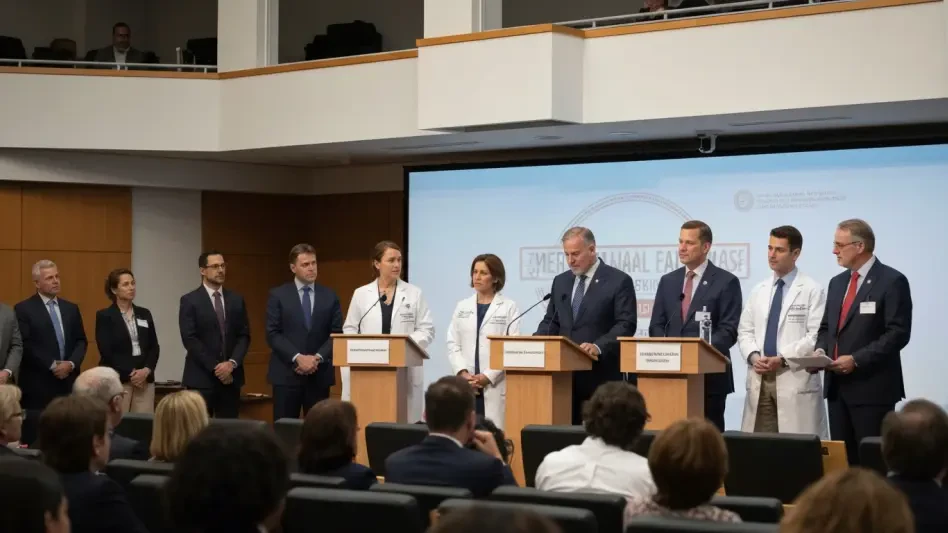The landscape of American healthcare stands at a critical crossroads as the debate over physician-owned hospitals (POHs) intensifies, carrying profound implications for access, equity, and financial stability across the sector. With over 150 rural hospitals closed since 2010 and many more on the brink of collapse, the question of whether POHs are a lifeline for underserved communities or a threat to traditional community hospitals has never been more pressing. This clash of perspectives—pitting hospital trade groups against physician advocates—highlights a deeper struggle to balance innovation with stability in a strained system. As legislative efforts gain traction and data-driven arguments emerge on both sides, the resolution of this issue could reshape healthcare delivery for millions of Americans.
Understanding Physician-Owned Hospitals and Their Role in U.S. Healthcare
Physician-owned hospitals, facilities in which doctors hold financial stakes and often direct operations, have a complex history in the U.S. healthcare ecosystem. Their numbers grew significantly from fewer than 70 in the early 2000s to around 250 by 2010, driven by a demand for specialized care in fields like orthopedics and cardiology. However, a federal moratorium enacted in 2010 halted the creation or expansion of new POHs, citing concerns over self-referral and market inequities, leaving their current count stagnant and their future uncertain.
These hospitals play a unique role by focusing on niche services, often delivering high-quality outcomes in both urban centers and rural regions. Their appeal lies in tailored patient experiences and physician-led decision-making, which many argue enhances care delivery. Yet, their limited scope—often lacking emergency departments—raises questions about their ability to serve as comprehensive care providers, especially in areas with scarce medical resources.
Key stakeholders in this debate include hospital trade groups such as the Federation of American Hospitals (FAH) and the American Hospital Association (AHA), which advocate for community hospital interests, and physician groups like the American Medical Association (AMA), which champion POHs as vital to patient choice. Amid broader challenges like rural healthcare access, where closures worsen disparities, POHs are positioned as both a potential solution and a point of contention, highlighting the need for nuanced policy approaches.
Competing Perspectives on Physician-Owned Hospitals
Arguments Against POHs: Financial and Operational Concerns
Hospital trade groups have long opposed POHs, citing significant financial risks to community hospitals, particularly in rural settings already facing economic hardship. A study by Dobson | DaVanzo, commissioned by these groups, illustrates the threat, projecting that a community hospital with a typical profit margin of 2.5% could see it drop to -1.2% if a nearby POH specializing in high-revenue services like cardiac care emerges. Such a decline could push already struggling facilities toward closure.
Beyond finances, operational critiques focus on the limited scope of many POHs, which often lack emergency departments. This gap means critical cases must be transferred to community hospitals, placing additional strain on these facilities and emergency services. Critics argue that this dynamic undermines the safety net role of traditional hospitals, especially in underserved areas where resources are scarce.
Another concern is the practice of “cherry-picking,” where POHs are accused of selectively treating healthier, commercially insured patients, leaving community hospitals to manage sicker, underinsured populations. This imbalance, according to the AHA and FAH, distorts fair competition and worsens disparities, as community hospitals bear the burden of uncompensated care while POHs capitalize on profitable cases.
Advocacy for POHs: Enhancing Access and Innovation
On the other side, physician groups and supportive lawmakers argue for lifting the 2010 moratorium, emphasizing the potential of POHs to improve patient outcomes and expand access to specialized care. In rural areas, where healthcare options are often limited, POHs could fill critical gaps, offering services that might otherwise require long-distance travel. Voices like Dr. Adam Bruggeman of the American Association of Orthopedic Surgeons assert that physician leadership drives better results for patients.
Legislative efforts reflect this push, with bills like the Physician-Led and Rural Access to Quality Care Act (H.R. 2191 and S. 1390) gaining bipartisan support—boasting 31 House and 9 Senate co-sponsors. These proposals aim to relax restrictions while including safeguards, such as mandating a minimum distance of 35 miles between new POHs and existing community hospitals, to mitigate direct competition.
Proponents also highlight the capacity for innovation in physician-led models, suggesting that POHs can streamline operations and prioritize patient-centric care. By focusing on efficiency and specialty expertise, these facilities could set new standards in healthcare delivery, potentially benefiting the broader system if integrated thoughtfully with existing infrastructure.
Challenges Facing Rural Healthcare and the POH Debate
Rural healthcare in the U.S. faces a dire crisis, with over 150 hospital closures since 2010 and roughly half of remaining rural facilities operating at a loss. This wave of instability threatens access to essential services for millions, increasing travel times for emergency care and routine treatments. The debate over POHs intersects directly with this issue, as their presence could either alleviate or worsen the strain depending on policy design.
POHs are often framed as a double-edged sword in this context. On one hand, they offer a potential lifeline by bringing specialized care to remote areas; on the other, their competition risks further destabilizing community hospitals already on shaky financial ground. The loss of these traditional facilities often means the collapse of local emergency services, a burden that POHs, with their limited scope, are ill-equipped to shoulder.
Addressing this tension requires creative solutions beyond the binary of banning or endorsing POHs. Targeted interventions, such as federal funding for rural health infrastructure or incentives for collaborative models between POHs and community hospitals, could help balance competition with stability. Without such measures, the societal cost of closures—both in access and economic vitality—will continue to mount.
Regulatory Landscape and Legislative Developments
The 2010 federal moratorium on new or expanded POHs stemmed from concerns over physician self-referral and the potential for market distortion, effectively freezing the growth of these facilities. Enacted as part of broader healthcare reform, the ban aimed to protect community hospitals from losing high-revenue patients to physician-led competitors. Its impact has been profound, stalling a once-rapid expansion while fueling ongoing debate over its relevance today.
Current legislative efforts signal a shift, with bipartisan proposals like H.R. 2191 and S. 1390 seeking to amend the ban by allowing POHs in rural areas under strict geographic conditions. Supported by a diverse coalition in Congress, these bills reflect a growing recognition of rural healthcare challenges and a willingness to revisit restrictive policies. Their progress, however, remains uncertain amid opposition from powerful hospital advocacy groups.
Broader policy initiatives also play a role, such as past rural health programs backed by significant federal investment, including a $50 billion commitment under previous administrations to bolster rural infrastructure. These efforts could pave the way for POH-friendly reforms, though compliance issues—particularly around self-referral criticized by hospital groups—demand careful oversight to ensure equitable market practices and prevent exploitation.
Future Outlook for Physician-Owned Hospitals
Looking ahead, the trajectory of POHs hinges on a volatile political landscape and sustained bipartisan interest in rural healthcare solutions. With both parties acknowledging the urgency of access disparities, there is potential for legislative breakthroughs that could redefine the role of these facilities. However, entrenched opposition from hospital trade groups ensures that any change will face rigorous scrutiny and debate.
Emerging trends, such as advancements in specialty care technology and rising consumer demand for localized services, could further bolster the case for POHs. These disruptors may encourage more efficient, patient-focused models, positioning physician-led facilities as innovators in a crowded field. Yet, the risk of deepening financial divides for community hospitals remains a critical counterpoint that policymakers must address.
Global economic conditions and domestic healthcare policy shifts will also shape the feasibility of POH expansion in the coming years. If funding for rural health remains a priority, and if physician-led models can demonstrate measurable benefits without undermining broader system stability, their integration could herald a new chapter in care delivery. Balancing these dynamics will be essential to avoiding unintended consequences.
Conclusion: Navigating a Divisive Healthcare Issue
Reflecting on the heated discourse surrounding physician-owned hospitals, it becomes evident that both hospital trade groups and physician advocates bring substantial arguments to the table. The concerns over financial strain on community hospitals, backed by concrete data, stand in sharp contrast to compelling evidence of improved access and innovation through POHs. This divide underscores a shared urgency to tackle rural healthcare challenges, even as solutions diverge.
Moving forward, policymakers should prioritize targeted legislation that allows POH growth in underserved regions while implementing safeguards to protect vulnerable community hospitals from competitive fallout. Collaborative frameworks, such as shared service agreements or federal incentives for hybrid models, could bridge the gap between these opposing visions. Ultimately, fostering dialogue and innovation offers the best path toward an equitable healthcare system that serves all Americans effectively.









